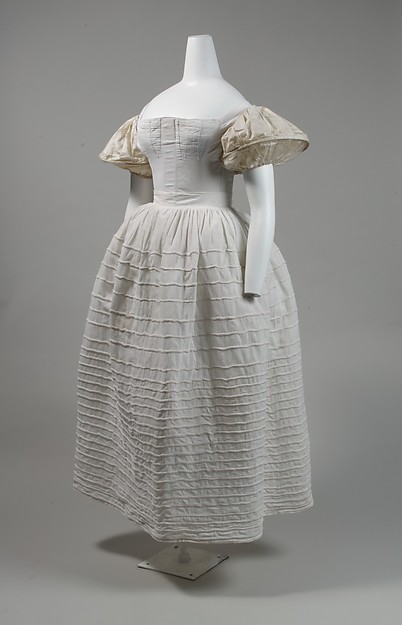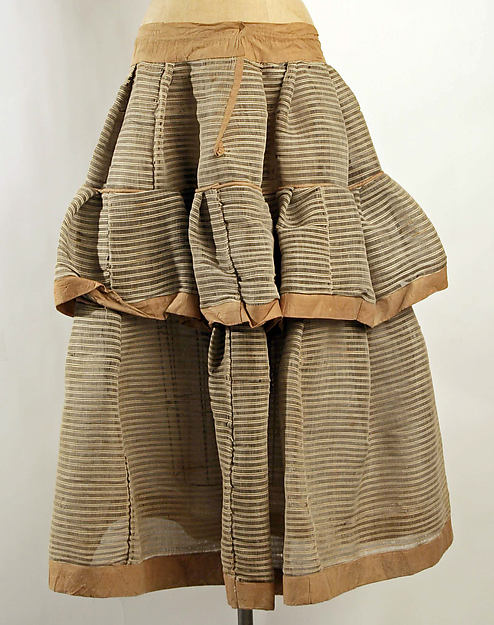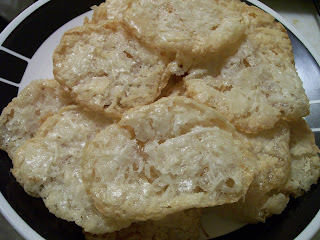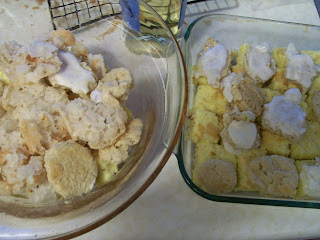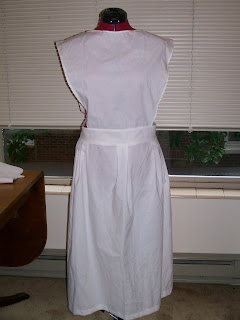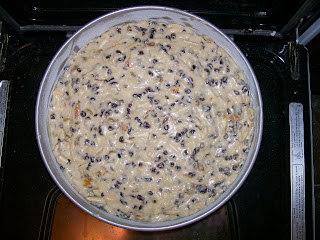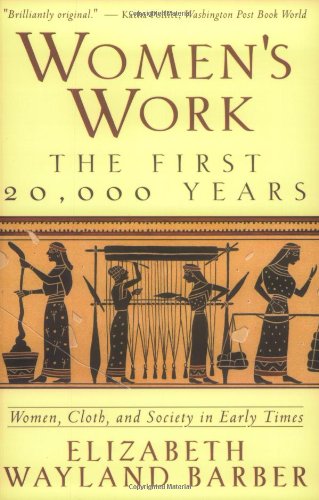The Challenge: Culinary Vices
The Recipe: A Trifle from
Mrs. Hale's New Cook Book by Mrs. Sarah Josepha Hale (pages 366,)
For the sponge cakes (page 406):
Ratafia cakes (page 413):
For reference, the preceding almond cakes:
Incidentally, the month lead time means I won't be making my own ratafia, but there's a receipt for that too (page 446):
Macaroons (page 412):
And the "rich custard" (365):
Sugar, cream, brandy, wine, more sugar, more brandy, more cream... I think this receipt is
very well-suited to the challenge.
The Date/Year and Region: 1857, United States (Philadelphia)
How Did You Make It:
Day 1: Ratafia cakes, and coconut macaroons.
Pounded just over 1 lb (~1.15 lb) of blanched almonds (initially with a mortar and pestle, the rest in a blender). Mixed in 2 cups of powdered sugar (just over 1/2 lb) and 1/2 cup peach brandy; I also added 1/2 tsp of almond extract (diluted essence of bitter almond), in lieu of using actual bitter almonds. It made a very sticky dough. Rolled into balls and flattened into small cakes; baked on parchment paper at 300F for about 10 minutes per side, to "dry". Mixed up icing with 3 cups of powdered sugar and 1 egg white and iced one side of cakes; dried in oven. Having run out of icing, and having some difficulty applying it to the other side of the cakes, I opted to leave them half-frosted.


I doubled the macaroon receipt, to neatly use the whole bag of shredded coconut. Unfortunately, this made the volume of ingredients exceed the capacity of any of my mixing bowls. That's 1 lb shredded coconut, mixed with 4 pounds (ie, the whole bag) of granulated sugar and the whites of two eggs. Eight egg whites were separately beaten to a "froth", and then stirred into the batter. Baked on parchment paper at 350F, for about 10 minutes on the lower rack and 5 on the upper oven rack.
Day 2: Sponge cake, custard, whipped cream, and assembling the trifle.
Sponge cake: Separated 10 eggs, beat the whites until fluffy, and the yolks until well-mixed. Added 1 lb sugar, lemon juice, and minced lemon peel to the yolks. Stirred in egg whites and 1/2 lb flour; baked in a greased and floured pan for about 40 minutes at 350F (until the center was solid). Next time, I'd probably put it a little higher in the oven--it was on second lowest rack position, and the bottom/sides were getting a bit well done by time the center was baked.
Custard: I ended up making this twice to cover both trifles. Put 1 cinnamon stick and the peel of 1 lemon in 2 cups of milk on the stove, on medium heat, and allow it to boil for between ten and fifteen minutes. Meanwhile, separated 8 eggs and beat the yolks with 2 cups of cream. Strained heated milk and stirred in about 1/2 cup of sugar. Slowly added hot milk to the eggs/cream while mixing. Slowly heated the custard on the stove top, stirring, for 1 1/4- 1 1/2 hours on medium low heat, until the custard thickened.

The whipped cream had... issues. I started mixing 3 cups of cream, added 3/4 cup of sugar and 1 cap-full of brandy (about 1 Tbsp). Added 3/4 cup moscato, and... the cream didn't set. Probably, I should have gotten it fully whipped with the sugar, and then stirred in the other flavorings. I tried straining the mixture, but it went straight from runny to grainy, and I ended up with...butter. Sweet, alcohol-laced, butter. [Fortunately, a friend decided this was brilliant, and whisked it off for French-toast purposes.]
I tried it again with the remaining cup of cream, only adding 1/4 cup of sugar, and the small splash of brandy. It still, however, wouldn't solidify.
To finally construct the trifle, I started by layering slices of sponge cake with macaroons and ratafia cakes. Even with two decent-sized dishes (and a third small one for a non-alcoholic version), I only ended up using about half of the ratafias and a quarter of the (double batch of) macaroons. Fortunately, the leftovers were tasty on their own.
I poured about half a bottle of moscato with a splash of brandy, over the cakes and let them soak while making the custard. For the non-alcoholic small dish (not pictured), I used a splash of orange-flower water on the sponge/macaroons. When the custard was thick, I poured it over the cakes, topping it off with minced orange peel and fresh-grated nutmeg.
The square pan was full at this point (even though the custard barely covered the cakes, much less being 2" thick), so I only added the raspberry preserves to the deeper round dish, and the small non-alcoholic one. The whip cream didn't set, as mentioned above, and so I ended up drizzling it over the top.
Time to Complete: A really long time.
Total Cost: *mumble*
How Successful Was It?: Better than
last time! The macaroons are yummy on their own, if not pretty, likewise the ratafia cakes. The sponge had a nice lemon flavor. The custard actually thickened this time, and had a delicate lemon/cinnamon flavor. The whipped cream--the one portion of this that I wasn't at all concerned with--was a complete failure. Twice.
The trifle ultimately came together well, with the different flavors mixing and complementing eachother. I'm not usually a huge fan of soggy cakes, but only the sponge cake really had that problem--the ratafias/macaroons stayed nicely crisp. It was, however a huge project, and if I make it again in the future, it will only be because I have left-over period cakes and cookies to to re-purpose.
How Accurate Was It?: Recursively accurate. :) I still need a better dish for layering trifles, but they ones I found worked pretty well. Two things which I could have made according to period instructions, but didn't were the aforementioned ratafia, and the preserves--I opted for a ready-made in this case, because berries aren't in season at the moment, there was already so much else to do (and I have
made jelly before according to a Victorian receipt).

